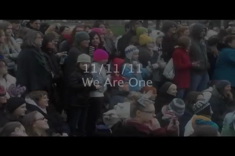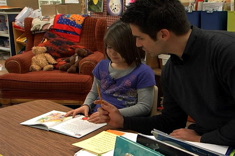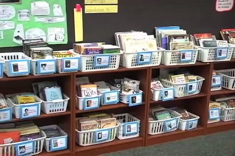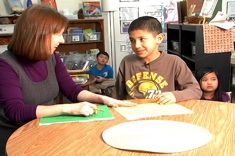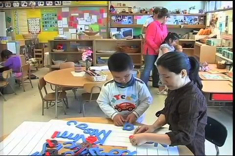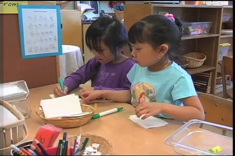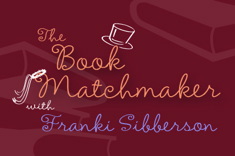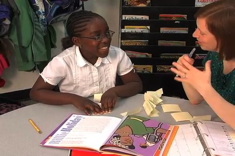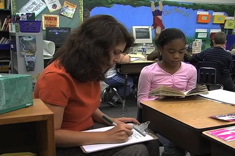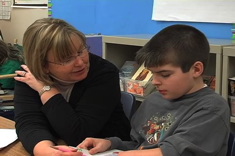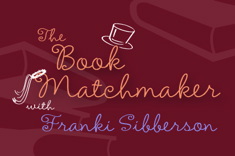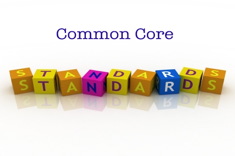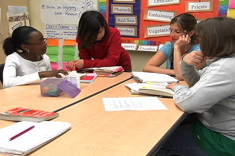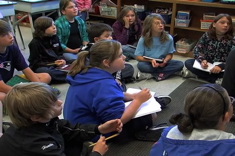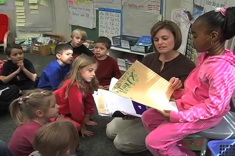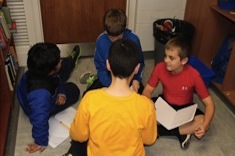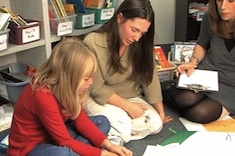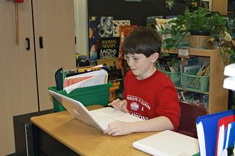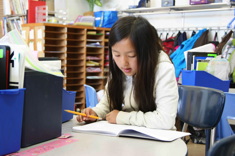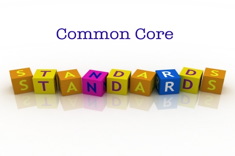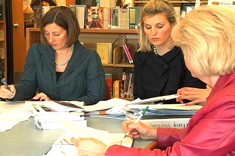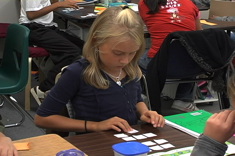Library
Choice Literacy Articles & Videos
The Choice Literacy library contains over 3,000 articles and 900 videos from 150+ contributors. Classic Classroom and Literacy Leadership subscribers have access to the entire library. Content is updated continuously, with five to six new features published each week.
Latest Content
Poetry that Celebrates Summertime and the Outdoors
Franki Sibberson combines verse and nature in this booklist on taking poetry outdoors.
11/11/11: We Are One Celebration with Amy Krouse Rosenthal
Hundreds of people gathered at Millennium Park in Chicago for a joyful and silly celebration of Amy Krouse Rosenthal’s “We Are One” flash mob.
Conferring About Chunking Words in Second Grade
Sean Moore confers with a 2nd grader who is learning the strategy of chunking words in reading. Notice how Sean focuses the student, refers to previous conferences, and previews an upcoming whole-class reading.
If You Like Junie B. Jones, You Might Like . . .
What young learner doesn’t love Junie B. Jones? Franki Sibberson shares great texts to recommend for readers who adore Junie and might be looking for similar characters and plots.
What’s On Your Summer Pleasure Reading List? (Round-Up)
We asked some of our favorite teacher authors what's on their nightstands and in their book bags for summer reading.
Stuck on a Thesis: Conferring
In this conference with a 4th grader, Beth Lawson works with a student who has chosen a challenging essay topic and is struggling to develop his thesis.
Preschool Centers
Centers can be an effective teaching and learning strategy in preschools. In this video, Melissa Kolb shares her rationale for using centers in her Head Start classroom with video examples of centers.
Preschool Thank-You Writing Center
Teachers Melissa Kolb and Andie Cunningham help preschoolers use the thank-you writing center in this quick two-minute video.
Learning to Write Engaging Nonfiction: A Middle School Partner Writing Study
Ann Marie Corgill takes a big risk and pairs her middle-school students randomly for a nonfiction writing project, and finds the risk pays off.
Book Matchmaker: Intermediate Read-Alouds
Franki Sibberson shares some of her favorite read-alouds for the intermediate grades.
Sticky Notes to Determine Importance
In this conference from Beth Lawson’s third-grade classroom, the focus is on the skill of determining importance in texts. Beth helps Sephina integrate sticky notes into her strategic reading of the book The Blues Singers.
Beyond Harry Potter: Tapping Student Interest in Fantasy
Franki Sibberson taps into the fantasy craze among students with this booklist.
Conferring About Rereading Strategies
In this conference with a fourth grader, Aimee Buckner guides a child to think more deeply and critically about a book being read to the whole class, Goblins in the Castle.
Reading Conferences in 5th Grade
Karen Terlecky confers with her 5th graders during reading workshop.
Book Matchmaker: Graphic Novels for a 6th Grader
Franki Sibberson has graphic novel suggestions for 6th grade girls.
Respond, Reflect, Rejoice: The 3 Rs of Writing Celebrations
Ruth Ayres explains how teachers might put less focus on big, showy events, and more on the daily small pleasures and joys of writing success in classrooms.
Argumentative, Opinion, and Persuasive Writing in the Common Core
What does the Common Core have to say about persuasive writing? Jennifer Burton explains how she and her colleagues are teasing out the differences between opinion, argument, and persuasive writing with students, and helping them develop this type of writing in authentic ways
How Do We Structure Small Groups? (Part 3 of the Grouping Series)
Heather Rader synthesizes recommendations and provides examples of how grouping structures work in classrooms.
Standards and Magic: Digging Deep and Being Spontaneous with Infographics
If you’ve ever had 15 minutes or less to plan for a session with kids, you can appreciate the blend of panic and improvisation the experience inspires. Mary Lee Hahn devises an activity with an infographic for the 4th and 5th grade environmental science club at the last minute, and finds students exhibit many surprising literacy skills during the session.
Setting the Stage for Historical Fiction
In this demonstration lesson from a fifth-grade classroom, Aimee Buckner works with students to construct an anchor chart for understanding the genre of historical fiction.
More Productive Writing Share Sessions in First Grade
In this video from a first-grade classroom, Katie DiCesare demonstrates how she has made writing share time more productive by linking student work to recent lessons.
Inferring and Synthesis: Conferring Over Series Books
Beth Lawson shows how to get the most from a conference about series books in 3rd grade. Inferring and synthesis are discussed, as well as the use of written notes for making meaning from texts.
Grouping: Who? How Big? How Often?
In this first installment of a series on grouping, Heather Rader considers size, composition, and frequency.
If You Like Goosebumps . . .
Students still love the Goosebumps series, and teachers can build on that passion by introducing them to other texts with similar appeal. Franki Sibberson shares books at a variety of reading levels which tap into student fascination with things that go bump in the night.
Listen In: Magnifying a Moment in Writing
Sometimes using a prop can help young students understand a revision strategy. Heather Rader helps second-grader Sammi understand how to “magnify” a moment when revising her writing.
The Affect of Tech on Splrs
Heather Rader considers the cultural divide between teachers and students who are “screenagers” when it comes to texting. If u r getting LOLed out in ur classroom u might want 2 read this.
When It’s Time to Abandon Your Writing
Writers in the real world abandon drafts all the time, yet it’s a strategy which isn’t often encouraged in classrooms. Heather Rader considers the thorny issue of how teachers can promote this strategy, yet still deal well with those students who never finish any drafts.
Unpacking the Common Core Standards: First Grade Information Texts
Franki Sibberson designs a booklist for tackling information texts in first grade.
Building Community Protocols
Clare Landrigan and Tammy Mulligan share two of their favorite protocols for building community among educators.
6th Grade Word Sort
In this six-minute video, Pam Pogson leads an open word sort with her 6th grade students.
Browse Content By
Type
Category
- Assessment Tools
- Big Fresh Archives
- Booklists
- Choice Numeracy
- Classroom Design
- Common Core
- Community Building
- Conferring
- Content Literacy
- Digital Literacy
- English Language Learners
- Equity
- Family Relations
- Free Samples
- Guiding Groups
- Leadership
- Literacy Coaches
- Mentor Texts
- Minilessons
- New Teacher Mentors
- Podcasts
- Poetry
- Quote Collections
- Reading Strategies
- Self Care
- Struggling and Striving Learners
- Talking and Listening
- Teacher Study Groups
- Teaching Reading
- Teaching Writing
- Word Study and Vocabulary
Author
- Melissa Quimby
- Nawal Qarooni
- Gwen Blumberg
- Julie Cox
- The Lead Learners
- Hannah Tills
- Josie Stewart
- Ruth Metcalfe
- Mallory Messenger
- Becca Burk
- Jodie Bailey
- Vivian Chen
- Mary Brower
- Tiffany Abbott Fuller
- Stephanie Affinito
- Ruth Ayres
- Leigh Anne Eck
- Heather Fisher
- Shari Frost
- Julie Johnson
- Suzy Kaback
- Gigi McAllister
- Shirl McPhillips
- Melanie Meehan
- Cathy Mere
- Debbie Miller
- Tara Barnett and Kate Mills
- Tammy Mulligan
- Dana Murphy
- Bitsy Parks
- David Pittman
- Brenda Power
- Heather Rader
- Matt Renwick
- Mandy Robek
- Christy Rush-Levine
- Gretchen Schroeder
- Jen Schwanke
- Brian Sepe
- Katherine Sokolowski
- Stella Villalba
- Jennifer Vincent
Grade Level
Choice Literacy Membership
Articles
Get full access to all Choice Literacy article content
Videos
Get full access to all Choice Literacy video content
Courses
Access Choice Literacy course curriculum and training


